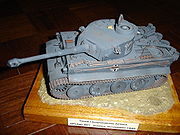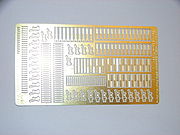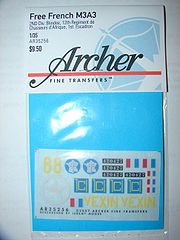
Model military vehicle
Encyclopedia


Scales
The term 'scale' refers to the proportion of actual size the replica or model represents. Scale is usually expressed as a ratio (e.g. '1:35') or as a fraction (e.g. '1/35th'). In either case it conveys the notion that the replica or model is accurately scaled in all visible proportions from a full-size prototype object. Thus a 1/35th scale model tank is 1/35th the size of the actual vehicle upon which the model is based. Models generally make no attempt to replicate scale weight, only size.Scales for commercially produced kits include 1/9, 1/16, 1/24, 1/35, 1/48, 1/72, 1/87 (railroad HO scale), 1/144, 1/250, 1/285 and 1/300. However, 1/35 and 1/72 are by far the most popular. A relatively new trend led by Tamiya is military vehicle kits in 1/48 scale — a popular scale for military aircraft models. The scale was formerly introduced by companies such as Aurora
Aurora
Aurora most commonly refers to:*Aurora , a glow in the sky seen at polar latitudes*Aurora , the goddess of the dawn in Roman mythologyAurora may also refer to:-Literature:*Aurora , a superheroine in the Marvel Universe...
, and Bandai
Bandai
is a Japanese toy making and video game company, as well as the producer of a large number of plastic model kits. It is the world's third-largest producer of toys . Some ex-Bandai group companies produce anime and tokusatsu programs...
in the 1970's. However, the scale did not gain popularity mostly because of the accuracy and detail of the scale. Scratchbuilt models may be in any scale but tend to follow the most popular kit scales due to the ease of finding kit components which may be used in the scratchbuilt model.
Larger-scale models tend to incorporate higher levels of detail, but even smaller-scale models may be quite intricate.
Subjects

Tank
A tank is a tracked, armoured fighting vehicle designed for front-line combat which combines operational mobility, tactical offensive, and defensive capabilities...
s and other armored fighting vehicles are the most popular subjects at model contests. Modelers also build ordnance, military trucks and half-tracks, and lighter vehicles such as jeeps and motorcycles. Models may be displayed in stand-alone mode, that is, with no base, or on a decorative base, often with a label of some kind. More elaborate bases may include scale scenery, intended to depict the setting in which the vehicle served. This trends towards the closely related hobby of diorama
Diorama
The word diorama can either refer to a nineteenth century mobile theatre device, or, in modern usage, a three-dimensional full-size or miniature model, sometimes enclosed in a glass showcase for a museum...
building.
Modelers tend to focus on vehicles from three eras. World War I, World War II, and the modern era. The first denotes armored vehicles from their inception into combat during the first World War until approximately 1939. Vehicles of this time period are considered to be experimental for the most part and did not make major contributions to what few battles they took part in.
Vehicles between 1914 and 1918 are not as numerous as their later world war counterparts, but are often just as commonly available, being produced by high-volume companies such as Emhar. Recently, there has been a trend amongst small producers to make resin add-ons and extra tank tracks, since those supplies by Emhar are tapes of soft plastic (Much like in 1:72 scale
1:72 scale
1:72 scale is a scale used for scale models, most commonly model aircraft, corresponding to one sixth of an inch representing one foot . In other words, 72 of a given model placed end to end would represent the length of the real thing. In this scale, a man who is six feet tall would be exactly...
rather than individual track links (As seen in most 1:35 scale models). Some companies (regardless of production number), particularly in Eastern Europe make little-known WWI designs such as the Tsar Tank
Tsar Tank
The Tsar Tank , also known as the Netopyr which stands for pipistrellus or Lebedenko Tank , was an unusual Russian armoured vehicle developed by Nikolai Lebedenko , Nikolai Zhukovsky , Boris Stechkin , and Alexander Mikulin...
or the K-Wagen. These are expensive and scarcely available outside the production country.
Vehicles used between 1939 and 1945 fall into the Second World War category. Even though this area spans the shortest number of years, it is by far the most popular for armor modelers due to the enormous range of vehicles used and the vast improvements in armor technology. During the early part of the war, most armored vehicles were smaller, less heavily armored, and lightly armed. Major tank engagements early on convinced governments on all sides of the need for more survivable and deadlier vehicles.
Any vehicle serving in a setting after 1945 is considered "modern". This encompasses a longer time span and very large number of armor designs from all countries.
Models may also be categorized by place of service, for example, US or Soviet. They may also be categorized by function, for example, combat engineering vehicles, recovery vehicles, etc. In all cases, the national and unit markings on the replica determine the era and user nationality. For example, a model of a Sherman tank, a World War II design, would be considered a 'modern' model if the tank were shown in Israeli markings from the Six-Day War
Six-Day War
The Six-Day War , also known as the June War, 1967 Arab-Israeli War, or Third Arab-Israeli War, was fought between June 5 and 10, 1967, by Israel and the neighboring states of Egypt , Jordan, and Syria...
. The same vehicle in World War II US Army markings would be considered a World War II Allied subject.
Models are generally built with historical accuracy in mind, and each model may represent many hours of research effort on the part of the modeler. Frequently, modelers display some of their research work alongside their model.
There is generally some crossover of modelers between the eras, though some focus solely on a specific era, country of origin/operation, or even to a specific vehicle.
Models and model kits




Kits
Models are usually assembled from commercial kits (but see below). Typically, a model kit consists of a set of parts, instructions for their assembly, and a small sheet of markings in decal form.Parts are produced by injection of liquid styrene plastic under very high pressure into complex steel molds. These molds are generally composed of two halves that sandwich the parts; however, 'slide molds' may consist of many steel components to allow greater levels of detail to be incorporated into a single sprue. Once the plastic cools, it is removed from the mold. In the 1960s and 1970s, typical vehicle kits might contain 50 to 200 individual parts. Today it is common for a single vehicle kit to contain from 300 to 1200 parts. Each part must be carefully cut from the 'sprue' (the plastic channels that allow the plastic to flow into the mold and which hold the parts in place), cleaned of any flaws or mold marks, and then assembled.
Instructions consist of paper booklets or sheets supplied with each kit. Usually, instructions show drawings of the parts. A recent trend has been the use of photographs rather than drawings, but these types of instructions have not proven popular and may be declining in use. For a kit with hundreds of parts, good instructions are vital. Flaws in instructions are not uncommon.
Markings for the model usually are provided as decals.
Several companies produce armor model kits, the most famous of which are Airfix
Airfix
Airfix is a UK manufacturer of plastic scale model kits of aircraft and other subjects. In Britain, the name Airfix is synonymous with the hobby, a plastic model of this type is often simply referred to as "an airfix kit" even if made by another manufacturer....
, Dragon Models Limited
Dragon Models Limited
Dragon Models Limited is a Hong Kong based manufacturer of plastic model kits, diecast models and military action figures...
, Tamiya, Trumpeter
Trumpeter (company)
Trumpeter is a Chinese company that manufacturers plastic injection moulding military model kits. Their product line consists of model ships, aircraft, cars and military ground vehicles. Trumpeter kits initially had a reputation of being somewhat less detailed than those of competitors such as...
, Academy
Academy Plastic Model Co.
Academy Plastic Model Co., Ltd. is a Korean plastic model, chemical, and toy company. It is headquartered in Uijeongbu-Si, Gyeonggi-do, Korea and was established on September 1, 1969. It holds three headquarters in Seoul, Korea; Gelsenkirchen, Germany; and Rosario, Cavite, Philippines...
, Hobby Fan, Italeri
Italeri
Italeri Incorporated is an Italian manufacturer of plastic scale models of airplanes, military vehicles, helicopters, ships, trucks, cars and figures...
, Revell
Revell
Revell is the brand name today of two manufacturers of scale plastic models. The original US company merged with another, Monogram, but now trades only under the Revell name. European Revell Germany separated from the US company in 2006.-Early history:...
-Germany/Monogram and AFV Club. The focus of many manufacturers of late has been to increase the accuracy of their kits and provide alternative types of material such as photo etch details and turned metal barrels.
Models
Completed models can be categorized generally into three classes: kits built 'out of the box', customized kits, and scratchbuilt models."Out of the box" models
Models built 'out of the box' are built according to kit instructions, using no materials except those provided in the kit itself. In the past, there was some tendency to view 'out of the box' builds as simpler or of a lower standard of detail than modified kits (see below). However, recent trends in which kits contain over 1,000 individual pieces including parts from plastic, etched brass, and aluminum have given new meaning to the 'out of the box' build. Today, a stock kit can be very highly detailed.Customized models
Customized kits are typically built by more experienced modelers who take a kit and add components, either scratchbuilt or commercial conversion or aftermarket accessories. Such models may be more highly detailed than a straight build 'out of the box' though the trend to more detailed kits is decreasing the difference. The term 'kitbashing' denotes models built using parts from more than one kit to make a single, more accurate or different model. Many armor modelers engage in the use of aftermarket sets and built from scratch (scratchbuilt) parts to make their models more accurate or simply unique. In extreme, master-level cases, a model with hundreds of kit components may be detailed with several hundred additional commercial and home-fabricated parts to reach a very high level of realism.Scratchbuilt models
Scratchbuilt models are those for which no kit exists; highly skilled modelers create their vehicle from sheet plastic and components they fabricate themselves. Some scratchbuilt models may contain a few commercial components, but typically it is a small proportion of all the model's parts.Scratchbuilt models may also be made from brass and aluminum, cast in pewter (a low temp metal) and cast with 2-part resins in molds made of RTV rubber material. A scratchbuilding modeler should possess talents in the following areas: soldering, gluing, drilling, taping, grinding, sanding, cutting & shaping in metals and plastics, creating RTV molds (1,2 & 3 part types), painting & weathering, research of prototype material, casting in low temp metals, creating sketches and diagrams of what is being made, measuring in inches and millimeters, use of calipers and other specialized tools.
Aftermarket
"Aftermarket" is a term that denotes any kit or detail set that is sold to replace existing kit parts in order to reproduce a more accurate model or simply a different version not otherwise available. The media used by aftermarket companies range from turned aluminum and brass, photo-etched steel or brass sheets, pre-bent brass wire, cast metals, and resin. Notable aftermarket companies include Formations, The Tank Workshop, Tank, Azimut, Eduard, Verlinden, Friulmodel, Legend, and Modelkasten.Aftermarket markings are also available. Firms such as Archer Dry Transfers or Decalomaniacs produce stand-alone sheets of wet or dry transfer markings to allow the modeler to complete a different or more accurate variant.
Enthusiasts may pursue military vehicle modeling in its own right or as an adjunct to other military model
Military model
Military miniaturism describes a hobby that covers military themed miniaturism of many types including,* aircraft* figures, tin soldiers* ships* vehicles* weapons, emplacements or equipment* science fiction themes...
ing. There is also some crossover with wargaming
Wargaming
A wargame is a strategy game that deals with military operations of various types, real or fictional. Wargaming is the hobby dedicated to the play of such games, which can also be called conflict simulations, or consims for short. When used professionally to study warfare, it is generally known as...
, diorama building, and re-enacting.
Displays
Models may be displayed on their own, on a base or as part of a diorama.Many models are displayed with no base or other setting. Their wheels or track rest upon the shelf or table on which they are displayed. This display method is the easiest and cheapest, but has the disadvantage that the fragile model may be damaged when handled.
A simple wooden base adds an element of protection to the model, because the model itself does not need to be handled. The model can be moved by handling the base. Bases may also hold a plate with some information about the model, such as the title of the work or some historical background. The base typically consists of a frame of wood or other material. Finishes on bases range from painted plastic to stained wood to simple landscaping. The disadvantage is that the base adds expense and time to the project.
A diorama
Diorama
The word diorama can either refer to a nineteenth century mobile theatre device, or, in modern usage, a three-dimensional full-size or miniature model, sometimes enclosed in a glass showcase for a museum...
is a more elaborate base with landscaping to provide a setting for the model, and often includes a story with figures
Model figure
A model figure is a scale model representing a human, monster or other creature. Human figures may be either a generic figure of a type , a historical personage , or a fictional character .Model figures are sold both as kits for enthusiast to construct and paint and as pre-built, pre-painted...
. Dioramas have the same advantages and disadvantages of plain bases, but to a greater degree.
Models are often displayed in competition such as the AMPS
Armor Modeling and Preservation Society
The Armor Modeling and Preservation Society is a social club with the common interest of modeling miniature armored fighting vehicles, military model figures, ordnance, dioramas, and related equipment...
annual show, or in club displays at hobby shops and other events.
Organizations and Publications
Several organizations and publications exist to support and promote the hobby of modeling military vehicles. The Armor Modeling and Preservation SocietyArmor Modeling and Preservation Society
The Armor Modeling and Preservation Society is a social club with the common interest of modeling miniature armored fighting vehicles, military model figures, ordnance, dioramas, and related equipment...
or AMPS is a 800-plus member organization devoted to the hobby. The International Plastic Model Society supports modelers of all types including military vehicle modelers. The Miniature Armoured Fighting Vehicle Association (MAFVA, http://www.mafva.net/) is a UK-b
Commercial publications devoted to or including military vehicle modeling include AFVModeller, Military Miniatures In Review (MMiR), Armour Modelling, and Military Modelling.
External links
- Modeler Site Armor/AFV, cars, aircraft scale modeling
- MilitaryModels(NZ) 1/35 WWII Military Modelling Site for Modelling tips, information, reviews and news
- Scale Plastic & Rail Reviews, builds and news site. Focussed on quality reviews
- http://www.modelarmour.com/ ModelArmour
- AMPS AFV modeling society
- Armorama.com Armor/AFV scale modeling
- Missing-Lynx AFV model making, all scales
- Track-Link AFV model making, all scales
- Track 48 AFV model making focused on 1/48 scale
- On The Way AFV model making focused on 1/72 scale
- ScaleModel.NET Searchable web directory of military scale model related websites around the world
- Small Scale AFV AFV model making focused on 1/72 and 1/76 scales
- Diecast 72 Information on 1/72 prebuilt & prepainted AFV's
- Panzermodel Forum Panzermodel Forum - Brazilian Forum, Armor/AFV and Information, all scales English translation SOON!
- planetArmor planetArmor forum

